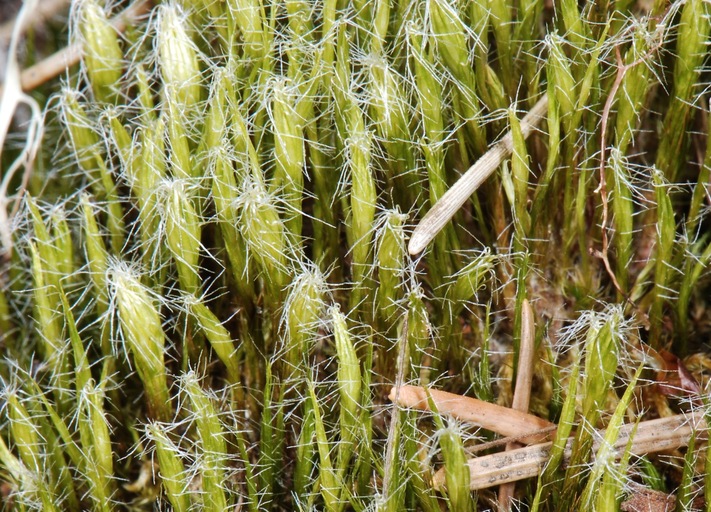![University of California [UC]](http://ucjeps.berkeley.edu/common/images/logo_uc_80.png)
![University of California [UC]](http://ucjeps.berkeley.edu/common/images/logo_uc_80.png) |
|||||
| University of California, Berkeley | |||||
| Directory News Site Map Home | |||||
California Moss eFlora
|
Jan 1 2013 ·
Home ·
List of Genera ·
Key to Keys ·
Accepted Names ·
Synonyms ·
For Beginners ·
Subdivisions of CA ·
Jepson eFlora for CA Vascular Plants |

NEEDS GENUS PARAGRAPH
Key to Campylopus Etc.
The mosses included in this key are rather large mosses with subulate or lanceolate leaves in which at least 1/3 of the leaf base is filled by the broad and flat costa. In most species that costa is percurrent to excurrent and fills most or all of the distal subula.
Species included in this key are in Dicranaceae:
Atractylocarpus flagellaceus (C. Müller Hal.) R. S. Williams
Campylopodiella stenocarpa (Wilson in Seeman) P. Müller & Frahm
Campylopus atrovirens De Notaris, not known from CA
Campylopus introflexus (Hedwig) Bridel
Campylopus pilifer Bridel, not known from CA
Campylopus pyriformis (F. Schultz) Bridel
Campylopus schmidii (C. Müller Hal.) A. Jaeger
Campylopus subulatus W. P. Schimper in Rabenhorst
Dicranodontium denudatum (Bridel) E. Britton in R. S. Williams, not known from CA
Paraleucobryum enerve (Thedenius in C. J. Hartman) Loeske, not known from CA
Median leaf cross-sections are normally required for the identification of Campylopus and its relatives. Of special importance in this large grouping of tropical and Southern Hemisphere mosses is the nature of the stereid bands. The stereid bands are formed of clusters of cells with walls so thick as to almost obscure the lumen. The plants here considered have some development of stereid-like cells on at least the abaxial side of the costa. Sometimes there are only groups of substereids (thick-walled cells but with the lumen appearing to be more than a pin-prick in microscopic view). Campylopus may have both an abaxial and an adaxial stereid band with the two bands separated by a row of thin-walled and large "guide cells." Sometimes the abaxial stereid band is not continuous across the width of the costa but is formed of islands of stereids separated laterally by groups of more enlarged and thin-walled cells.
A. Costa with stereid bands on both abaxial and adaxial sides, mostly with well-differentiated epidermises on both surfaces but without abaxial ridges .....B
A. Costa without a well defined adaxial stereid band; epidermises and abaxial ridges various .....D
B. Leaf base with marginal cells more narrow than those interior to the margin and therefore with little differentiation of the alar region .....Campylopodiella: C. stenocarpa
B. Leaf with most of the basal marginal cells quadrate and inflated strongly defining an alar region .....C
C. Median cells of leaf linear and porose; subula occupying more than 1/2 of leaf; older leaves on stem readily caducous .....Dicranodontium: D. denudatum not known from CA
C. Median cells of leaf rectangular but not porose; subula shorter; leaves not caducous .....Atractylocarpus: A. flagellaceus
D. Costa filling nearly all of leaf with cross-section 3-cells thick and with thin-walled cells on both surfaces with the interior layer of cells smaller and deeply chlorophyllose .....Paraleucobryum: P. enerve not known from CA
D. Costa somewhat more narrow, without a median layer of chlorophyllose cells .....E
E. Plants with fragile shoots so that the surface of the plant is often covered with fragments of small leafy shoots; costa without stereids or with a weak and interrupted layer of abaxial stereids; leaves typically without hyaline awns .....F
E. Plants without such fragile shoots; costa with a strong and continuous layer of abaxial stereids; leaves typically with hyaline awns .....G
F. Leaves evenly contracted from base to apex; costa without stereids with the abaxial cross-section showing substereids .....Campylopus subulatus
F. Leaves with a broadened base that abruptly contracts into a subulate apex mostly filled with the costa; costa mostly with a band of abaxial stereids .....Campylopus pyriformis
G. Basal juxtacostal cells thick-walled and porose with a strong red-brown pigmentation; cells of distal portion of leaf linear and vermiculose .....Campylopus atrovirens not known from CA
G. Basal juxtacostal cells not so differentiated; cells of distal portion of leaf mostly shorter, not vermiculose .....H
H. Costa smooth abaxially .....Campylopus schmidii
H. Costa ribbed on abaxial surface .....I
I. Awns on dry plants reflexed away from plant axis about 90 degrees .....Campylopus introflexus
I. Awns erect even on dry plants .....Campylopus pilifer not known from CA